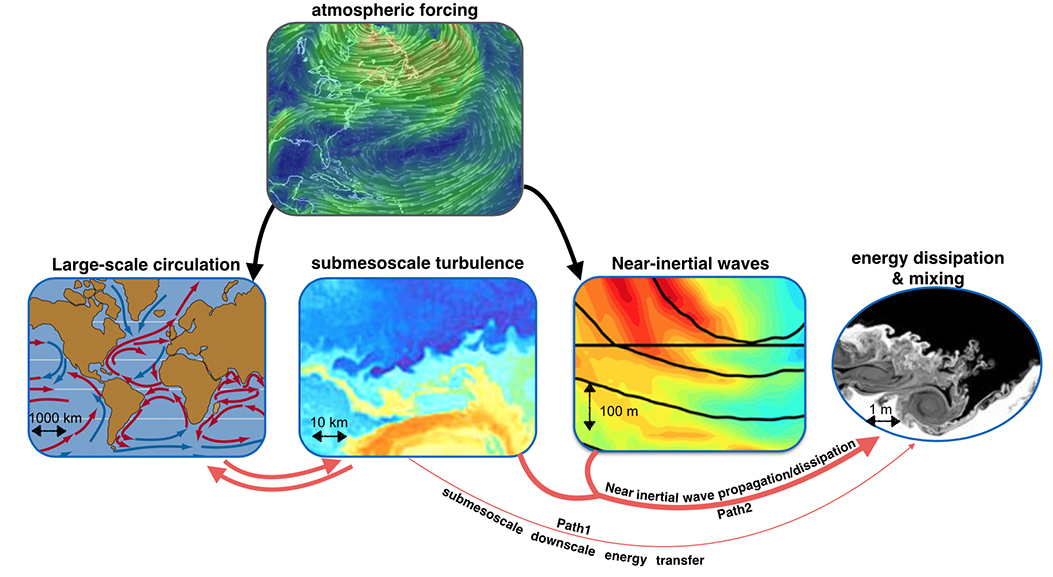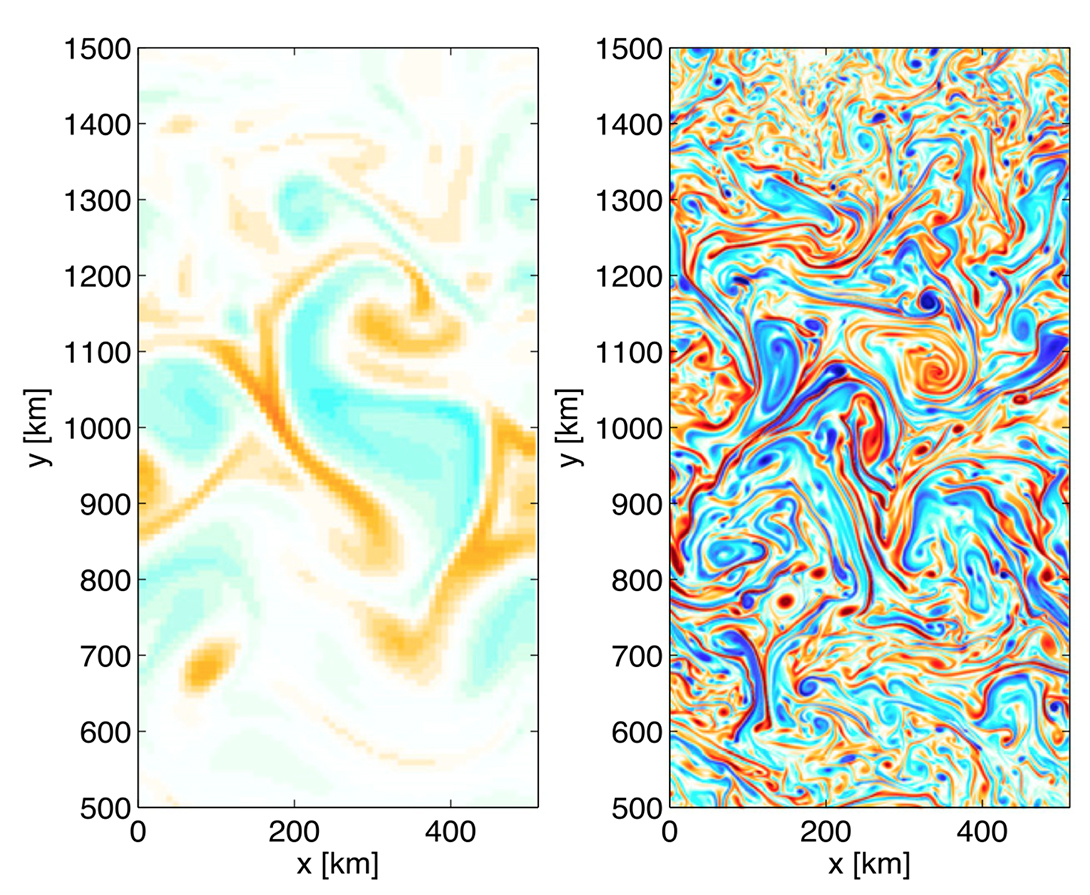ENVIRONMENT AND ENERGY
SubMesoscale Ocean Modelling for Climate
Principal Investigator:
Xavier Capet
Affiliation:
CNRS, LOCEAN laboratory, Université Pierre et Marie Curie, Paris (France)
Local Project ID:
PP14102208
HPC Platform used:
Hazel Hen of HLRS
Date published:
The SMOC (SubMesoscale Ocean Modelling for Climate) project aimed to shed light on the role of submesoscale turbulent processes in the overall functioning of the ocean. Leveraging HPC power, the researchers in particular tried to get answers to: A) how deep do submesoscale fronts penetrate and can they be a significant source of dissipation for the ocean circulation away from the surface?, and B) to which extent do submesoscale fronts participate in the transfer into the deep ocean of the near-inertial energy injected by the wind at the ocean surface?
Scientific context
As of now, many aspects of the ocean energetics remain poorly understood. One enduring conundrum concerns the energetic equilibration of the general large-scale circulation, which is made of well-known currents such as the Gulf Stream or the Antarctic Circumpolar Current ... In a nutshell, large amounts of energy injected into the ocean by the atmosphere drive flows with very large horizontal scales (1000 km or more, see Figure 1). To remain near equilibrium, the large-scale circulation must dissipate energy at roughly the same rate it receives it. On the other hand, dissipation is achieved through viscous forces acting on fluid motions with centimeter scales or less. To bridge the scale gap, a cascade of processes must transfer energy from large scales down to fine scales.
Many aspects of this downscale energy transfer are not known and even the dominant processes are not clearly identified. Because dissipation of the ocean circulation is a key source of water mass mixing, this issue has vast implications for Earth climate modelling.
Project objectives
The SMOC (SubMesoscale Ocean Modelling for Climate) project aimed to shed light on the role of submesoscale turbulent processes in the overall functioning of the ocean. Near the ocean surface, most flows spontaneously produce submesoscale density fronts whose typical horizontal scales are in the range of 1 to 10 km (figure 1 and 2). These fronts induce substantial energy dissipation and mixing. They are the analogous of atmospheric fronts present in weather systems and have been a subject of great research interest for the past decade.
The main SMOC research questions were: how deep do submesoscale fronts penetrate and can they be a significant source of dissipation for the ocean circulation away from the surface (energy pathway 1, see Fig 1)? And, to which extent do submesoscale fronts participate in the transfer into the deep ocean of the near-inertial energy injected by the wind at the ocean surface (energy pathway 2)?
Computational details
Simultaneously resolving submesoscale frontal turbulence and its accompanying large-scale environment is computationally expensive. Ocean models have not been widely used in the submesoscale regime so the sensitivity of their behaviour to different choices of numerical schemes and parameters also need to be explored. This made the SMOC project challenging and computationally demanding.
Thanks to a PRACE allocation on HPC system Hermit (then Hazel Hen) of HLRS, the SMOC investigators were able to run a large number of “submesoscale rich” simulations in two different settings suited to explore and quantify pathway 1 and 2 respectively: 1) an idealized setting (figure 2) in which the ocean is forced as smoothly as possible so that the spontaneous emergence of submesoscale turbulence and its interaction with the large-scale circulation are unperturbed by other processes, 2) a more realistic setting in which the ocean circulation and its submesoscale turbulence interact with the circulation produced by atmospheric storms.
Main results
Careful analyses of over 50 long-term simulations carried out in the course of the project have revealed the smallness of the energy dissipation achieved by submesoscale turbulence into the ocean interior (pathway 1). They have, on the other hand, revealed the importance of submesoscale flows for the propagation of oscillatory motions excited near the ocean surface by atmospheric storms into the ocean interior (pathway 2).
The vertical distribution of near-inertial dissipation diagnosed in the SMOC simulations will now be used to constraint the parameterization of this process in NEMO, the ocean module of most european climate systems.

Figure 1: schematic representation of ocean energy pathways investigated in SMOC. Atmospheric winds and heat fluxes drive the oceanic large-scale circulation and inertia-gravity waves. The way these forced motions dissipate at very small scale is thought to depend on a class of turbulent processes termed “submesoscale”. SMOC investigators examined the role of submesoscale as an agent of energy dissipation in the ocean interior. They did so by numerically simulating all scales of motion between 1000 and ~1 km in the horizontal. High vertical resolution also allowed inertia-gravity waves to develop fine-scale velocity shear and dissipate realistically. SMOC conclusions tend to downplay the role of submesoscale alone as a conduit for dissipation of the ocean circulation (thin red arrow, pathway 1), away from the surface. Conversely, submesoscale as well as larger mesoscale turbulent structures play a key role in transporting large amounts of near-inertial energy from the surface into the ocean interior where that energy subsequently dissipates and produces mixing (large red arrow, pathway 2). The interplay between large-scale ocean circulation and its accompanying submesoscale turbulence was also explored.
Copyright: Xavier Capet
Figure 2: Vertical vorticity component at the ocean surface in two SMOC idealized simulations at horizontal resolution equal to 8km (left, eddy resolving) and 1 km (right, submesoscale rich). Only the central part of the 512 x 2048 km computation domain is represented. These two panels illustrate the emergence of upper-ocean submesoscale turbulence as the grid resolution of ocean models is being refined. When the meshgrid size becomes ~1 km or less, density fronts produced by frontogenesis and a variety of parallel flow instabilities become ubiquitous. These fronts have a profound effect on flow properties, for example on velocities which become increasingly concentrated as narrow jets. They increase the vertical exchanges of properties, which tend to be inhibited in the ocean, due to rotation and stratification effects. They also impact the ocean energetics. SMOC simulations on supercomputers Curie, Hermit and Hazel Hen have helped gain a better understanding of the dynamics of submesoscale turbulence and its role in the overall ocean functioning.
Copyright: Xavier CapetReferences:
Jouanno, J., X. Capet, G. Madec, Roullet, and P. Klein, 2016: Dissipation of the energy imparted by mid-latitude storms in the Southern Ocean, Ocean Science Discuss., 12, 743-769. http://www.ocean-sci.net/12/743/2016/
Capet X, G. Roullet, P. Klein and G. Maze, 2016: Intensification of upper ocean submesoscale turbulence through Charney instability, J. Phys. Oceanog., in press.
Scientific Contact:
Xavier Capet
Chargé de recherches CNRS
LOCEAN, IPSL
Université Pierre et Marie Curie
4, place Jussieu, Paris (France)
e-mail: xclod [@] locean-ipsl.upmc.fr